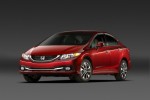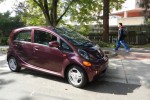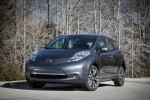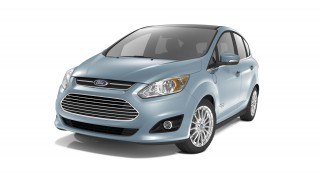The 2013 Ford C-Max is the company's first-ever "dedicated hybrid," meaning that there is no gasoline-only version sold in the U.S. With two versions available--a conventional hybrid and a plug-in hybrid as well--it directly targets the expanding range of Toyota Prius models, which now include a wagon (the Prius V) and a plug-in hybrid liftback on sale since early 2012.
The C-Max is a compact five-door hatchback, though it's viewed as a small minivan in Europe, where it sells with a variety of powertrains. For U.S. buyers, though, it comes in only two versions: a hybrid and a plug-in hybrid with a larger battery pack.
The powertrain is a 2.0-liter four-cylinder engine with the latest generation of Ford's two-motor hybrid system. Combined power output is 188 horsepower, fully 54 hp more than the Prius, and the C-Max feel distinctly peppier than Toyota's quintessential hybrid.
But there's still an unanswered question for those considering a C-Max Hybrid: What will its real-world fuel economy be? The EPA rates it at 47 mpg on all three test cycles--city, highway, and combined--but few testers have come close to that.
Our own road tests returned 37 mpg and 40 mpg. The Prius, on the other hand, generally returns real-world gas mileage figures within about 10 percent of the Liftback's combined 50-mpg rating (or 42 mpg combined for the Prius V wagon). We'll update this review when we have more data.
The C-Max Hybrid is clearly more pleasant to drive than the Prius. The sound insulation is better, so even when the engine revs hard, it's less intrusive. The added power seems to give the vehicle more pep than the Prius, despite several hundred pounds more weight.
In its shape, the 2013 C-Max is an upright five-door hatchback. Its lines aren't as memorable as the distinctive Prius, but they tie to Ford's global design language. The C-Max is built on the basic platform of the compact Focus hatchback and sedan, but it's much taller--and the driver sits higher. Inside, the dash and trim are less radical and far nicer in touch and feel than the Prius's Space Age-y Multi-Information Display and swathes of textured hard plastic trim.
The front seats are comfortable, and the tall body gives plenty of headroom for four 6-foot-plus adults. And the interior is filled with useful cubbies, bins, and other storage areas, including small hidden compartments in the rear footwells. Unusually, the load floor sits higher than the base of the tailgate, but the whole load bay has a family-friendly storage net and grocery-bag hooks.
Ford tends to position the hybrid C-Max not against the Prius liftback, but versus the Prius V wagon. It compares well on the numbers, with better fuel economy and better performance, though slightly less load space. And it's clearly a nicer place to spend time inside, though perhaps less flexible than the Prius wagon, with its sliding (and folding) rear seat.
The C-Max Hybrid offers 52 cubic feet of load space with the 60/40 split rear seats folded down (requiring just a single pull on a lever). With the rear seat up, cargo volume is 25 cubic feet. That's more than the Prius Liftback (21 cubic feet with the rear seat up), but less than the 34 to 40 cubic feet of the Prius V wagon with the sliding rear seat up--or its whopping 67 cubic feet with the seat down.
Because the C-Max Energi plug-in version has a much larger battery pack, its cargo volume is slightly lower--19 cubic feet with the rear seat up. Ford compare that model to the plug-in Prius hatchback. The C-Max Energi plug-in has more electric range to go along with the better performance: 21 miles on the EPA test cycle, compared to 6 miles continuous and 11 miles total for the plug-in Prius. It also allows the driver to choose among "EV Now" (all-electric), "EV Later" (conserve battery power for later use), and normal driving modes.
On a test drive, we found the plug-in C-Max to drive adequately--if not particularly swiftly--in all-electric mode in a variety of both city and highway uses. It was able to accelerate (leisurely) up a San Francisco hill and maintain freeway speeds, entirely on electricity. Like the Prius, the C-Max Energi will switch on its engine under hard acceleration, regardless of the battery's state of charge. But it's much harder to get the C-Max to do that, whereas the Prius often has to be treated gingerly in real-world usage to void kicking on the engine. Like the plug-in Prius, the C-Max Energi essentially reverts to being a conventional hybrid once its battery pack is depleted.
The plug-in hybrid C-Max actually went on sale in October 2012, even before journalists had a chance to drive the car. It's eligible not only for a $3,750 Federal income-tax credit ($1,250 more than the Prius plug-in, which has a smaller battery pack) but also a California carpool-lane access with only a single occupant, so it is likely to sell disproportionately in the electric-car friendly Golden State.
But the plain hybrid C-Max will be Ford's big-volume seller. Even if it gets slightly lower real-world fuel efficiency ratings than the Prius, Ford is betting that many buyers want a less extreme-looking vehicle that still identifies as a hybrid, and feels both quicker and better handling.
For more details, see the full review of the 2013 Ford C-Max range on our sister site, TheCarConnection.
Get more information
Related Articles
-
 2013 Ford C-Max Hybrid: Is It The Ideal Modern Family Car?
2013 Ford C-Max Hybrid: Is It The Ideal Modern Family Car?
-
 Hybrid Ad Wars: Ford C-Max Vs. Toyota Prius V
Hybrid Ad Wars: Ford C-Max Vs. Toyota Prius V
-
 2013 Ford C-Max Energi, Fusion Energi Join California HOV Lane
2013 Ford C-Max Energi, Fusion Energi Join California HOV Lane
-
 2013 Ford C-Max Hybrid: Quick Gas-Mileage Test
2013 Ford C-Max Hybrid: Quick Gas-Mileage Test
-
 2013 Ford C-Max Energi: 100 MPGe, Beats Volt, Plug-in Prius
2013 Ford C-Max Energi: 100 MPGe, Beats Volt, Plug-in Prius
-
 2013 Ford C-Max Hybrid: Can It Compete With Toyota Prius?
2013 Ford C-Max Hybrid: Can It Compete With Toyota Prius?
- Ford C-Max News
-
Follow Us
On Facebook
- New Car Price Quote


























































